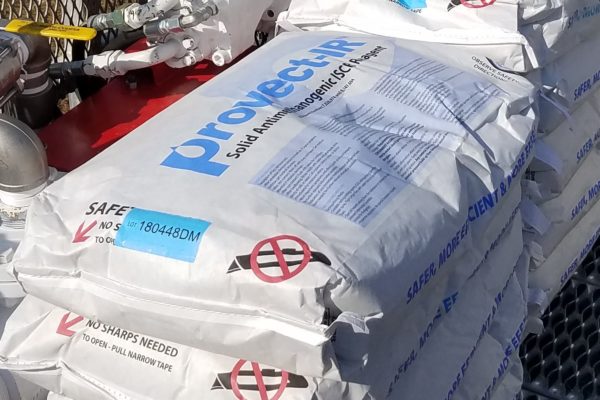ERD-CH4™ Antimethanogenic, Liquid ERD Amendment
Third International Symposium on Bioremediation and Sustainable Environmental Technologies | May 18-21, 2015 | Miami, Florida
By Jim Mueller (Provectus Environmental Products – Freeport, IL) and John Haselow (Redox-Tech, LLC – Cary, NC)
Problem: There are recognized benefits to methanogens and of limited methanogenesis. For example, i) methanogens are known to play important roles in synergistic microbial ecology, ii) their metabolic activity can help maintain anoxic conditions in treatment zones (through seasonal changes), and iii) the activity of methane mono-oxygenases and other enzymes can stimulate co-metabolic activity of TCE/DCE/VC in redox-recovery zones. Hence, limited production of methane is part of a healthy ERD/ISCR application. However, excessive methane production represents a costly waste of amendment (generating just 20 mg/L of methane constitutes greater than 33% of the total amendment consumption based on moles of H2; Mueller et al., 2014). Moreover, excessive and extended production of methane can result in elevated in groundwater concentrations (as high as 1,000 ppm have been reported) which can lead to accumulation in soil gas subsequently impacting indoor air, accumulating in basements, under slabs/foundations and/or migrate along utility corridors. Accordingly, State specific regulations for methane in groundwater have been promulgated. As a result, many remedial practitioners proactively design contingencies for conventional ERD implementation in the event that methane exceeds a threshold level ranging from 1 to 10 ppm groundwater. These contingencies often entail expensive and extensive systems for treating methane in soil gas/vapor captured via SVE systems.
Approach: To yield a liquid ERD amendment that enhances reductive dechlorination reactions while minimizing the production of methane we supplemented a proven ERD substrate (ABC™) with Provect-CH4™, a source of Monacolin K and other natural statins to inhibit the growth and proliferation of Archaea i.e., methanogens (Scalzi et al, 2013, 2014). The resulting product, ABC-CH4™, contains 60% water soluble carbon consisting of: glycerin as fast-release H donors, soluble lactic acid as mid-release H donors, ethyl lactate as a green solvent and H donor, dissolved Fatty acids as long-term release H donors plus dipotassium phosphate for micronutrients and pH buffering, and/or potash or bicarbonate for pH control. This is the only liquid ERD reagent designed to actively control the production of methane in a safe, reliable and predictable manner which represents a truly unique liquid, antimethanogenic ERD reagent.
Results: In August 2014, ABC-CH4 was added proximal to an existing monitoring well (MW-207s) to treat groundwater at an active shopping mall in Georgia, USA that was impacted by PCE and its catabolites (TCE, DCE and VC) from a former dry cleaning operation. At the same time, the same amount of a standard ERD amendment (no methane inhibitors) was added proximal to another existing monitoring well (MW-4) that was located ca. 200 feet cross gradient.
Prior to amendment application, baseline groundwater analysis were conducted for dissolved methane and COIs. Six weeks post application, groundwater samples were collected for similar analysis. At that same time, analysis of the head space gases in MW-4 and MW-207s was conducted using both a Thermo/Foxboro TVA-1000B PID/FID Analyzer (PID sensitive to 2,000 ppm CH4; FID sensitive to 50,000 ppm CH4) and a LandTec GEM5000 Landfill Gas (LFG) Meter (infrared detector calibrated to 15% methane). Well head space gases were analyzed from top of the well heads immediately upon opening the well caps with readings recorded every minute for 5 minutes. Data showed that MW-4 (water depth 11.9 ft bgs; pressure 0.11 in) treated with an ERD substrate only had over 30% CH4 in the headspace gas as measured by the GEM5000 LFG meter (note – TVA detectors exceeded their level of sensitivity and shut down). By comparison, the well headspace gas in MW-207s (water depth 18 ft bgs; pressure 0.24 in) had only 0.5% CH4.
Proposed Session:
Bioremediation Technologies and Implementation Practices:
Session 1b – Successes and failures of bioaugmentation and biostimulation
Corresponding Author:
Jim Mueller [email protected]
Provectus Environmental Products, Inc.
2871 West Forest Rd, Suite 2 | Freeport, IL 61032
Phone: (815) 650-2230
Coauthor:
John Haselow [email protected]
Redox-Tech, LLC
200 Quade Drive | Cary, NC 27513
Phone: (919) 678.0140

